Superregnum: Eukaryota
Cladus: Unikonta
Cladus: Opisthokonta
Cladus: Holozoa
Regnum: Animalia
Subregnum: Eumetazoa
Cladus: Bilateria
Cladus: Nephrozoa
Superphylum: Deuterostomia
Phylum: Chordata
Subphylum: Vertebrata
Infraphylum: Gnathostomata
Megaclassis: Osteichthyes
Cladus: Sarcopterygii
Cladus: Rhipidistia
Cladus: Tetrapodomorpha
Cladus: Eotetrapodiformes
Cladus: Elpistostegalia
Superclassis: Tetrapoda
Cladus: Reptiliomorpha
Cladus: Amniota
Classis: Reptilia
Cladus: Eureptilia
Cladus: Romeriida
Subclassis: Diapsida
Cladus: Sauria
Infraclassis: Archosauromorpha
Cladus: Crurotarsi
Divisio: Archosauria
Cladus: Avemetatarsalia
Cladus: Ornithodira
Subtaxon: Dinosauromorpha
Cladus: Dinosauriformes
Cladus: Dracohors
Cladus: Dinosauria
Ordo: Saurischia
Cladus: Eusaurischia
Subordo: Theropoda
Cladus: Neotheropoda
Cladus: Averostra
Cladus: Tetanurae
Cladus: Avetheropoda
Cladus: Coelurosauria
Cladus: Tyrannoraptora
Cladus: Maniraptoromorpha
Cladus: Maniraptoriformes
Cladus: Maniraptora
Cladus: Pennaraptora
Cladus: Paraves
Cladus: Eumaniraptora
Cladus: Avialae
Infraclassis: Aves
Cladus: Euavialae
Cladus: Avebrevicauda
Cladus: Pygostylia
Cladus: Ornithothoraces
Cladus: Ornithuromorpha
Cladus: Carinatae
Parvclassis: Neornithes
Cohors: Neognathae
Cladus: Neoaves
Cladus: Telluraves
Cladus: Australaves
Ordo: Passeriformes
Subordo: Passeri
Infraordo: Passerida
Superfamilia: Passeroidea
Familia: Icteridae
Subfamiliae: Agelaiinae – Amblycercinae – Cacicinae – Dolichonychinae – Icterinae – Sturnellinae – Xanthocephalinae
[sec. Remsen et al. (2016)]
Genera (30): Agelaioides – Agelaius – Agelasticus – Amblycercus – Amblyramphus – Anumara – Cacicus – Cassiculus – Chrysomus – Curaeus – Dives – Dolichonyx – Euphagus – Gnorimopsar – Gymnomystax – Hypopyrrhus – Icterus – Lampropsar – Leistes – Macroagelaius – Molothrus – Nesopsar – Oreopsar –Psarocolius – Pseudoleistes – Ptiloxena – Quiscalus – Sturnella – Xanthocephalus – Xanthopsar
Genera synonymized: Clypicterus – Ocyalus – Gymnostinops
Name
Icteridae Vigors, 1825
Typus: Icterus Brisson, 1760
References
Primary references
Vigors, N.A. 1825. Observations on the Natural Affinities that connect the Orders and Families of Birds. Transactions of the Linnean Society of London 14(3): 395–517. BHL Reference page.
Additional references
Barker, F. K., Burns, K. J., Klicka, J., Lanyon, S. M., & Lovette, I. J. 2013. Going to extremes: Contrasting rates of diversification in a recent radiation of New World passerine birds. Systematic Biology 62 (2): 298–320. DOI: 10.1093/sysbio/sys094 Full article (PDF)Reference page.
Powell, A. F.L.A., Barker, F. K., Lanyon, S. M., Burns, K. J., Klicka, J., & Lovette, I. J. 2014. A comprehensive species-level molecular phylogeny of the New World blackbirds (Icteridae). Molecular Phylogenetics and Evolution 71: 94-112. DOI: 10.1016/j.ympev.2013.11.009 Full article (PDF)Reference page.
Remsen, J.V. Jr., Powell, A.F.L.A., Schodde, R., Barker, F.K. & Lanyon, S.M. 2016. A revised classification of the Icteridae (Aves) based on DNA sequence data. Zootaxa 4093(2): 285–292. DOI: 10.11646/zootaxa.4093.2.9 Reference page.
Schodde, R. & Remsen, J.V., Jr. 2016. Correction of Cassicinae Bonaparte, 1853 (Aves, Icteridae) to Cacicinae Bonaparte, 1853. Zootaxa 4162(1): 188–188. DOI: 10.11646/zootaxa.4162.1.10 Reference page.
Lopes, L.E. 2017. Variation of plumage patterns, geographic distribution and taxonomy of the Unicolored Blackbird (Aves: Icteridae). Zootaxa 4221(4): 431–456. DOI: 10.11646/zootaxa.4221.4.2. Reference page.
Vernacular names
العربية: الصَّفراويَّات
Deutsch: Stärlinge
English: Icterids
Esperanto: Ikteredoj
español: Turpiales
suomi: Turpiaalit
magyar: Csirögefélék
lietuvių: Trupialiniai
Nederlands: Troepialen
norsk nynorsk: Trupialar
norsk: Trupialer
polski: Kacykowate
русский: Трупиаловые
中文: 拟黄鹂科
Icterids (/ˈɪktərɪd/) or New World blackbirds make up a family, the Icteridae (/ɪkˈtɛrɪdi/), of small to medium-sized, often colorful, New World passerine birds. Most species have black as a predominant plumage color, often enlivened by yellow, orange, or red. The species in the family vary widely in size, shape, behavior, and coloration. The name, meaning "jaundiced ones" (from the prominent yellow feathers of many species) comes from the Ancient Greek ikteros via the Latin ictericus. This group includes the New World blackbirds, New World orioles, the bobolink, meadowlarks, grackles, cowbirds, oropendolas, and caciques.
Despite the similar names, the first groups are only distantly related to the Old World common blackbird (a thrush) or the Old World orioles.
The Icteridae are not to be confused with the Icteriidae, a family created in 2017 and consisting of one species — the yellow-breasted chat (Icteria virens).[1]
Characteristics
Most icterid species live in the tropics, although many species also occur in temperate regions, such as the red-winged blackbird and the long-tailed meadowlark. The highest densities of breeding species are found in Colombia and southern Mexico.[2] They inhabit a range of habitats, including scrub, swamp, forest, and savanna.[3] Temperate species are migratory, with many species that nest in the United States and Canada moving south into Mexico and Central America.
Breeding male Brewer's blackbird apparently gaping (see text) in soil
Icterids are variable in size, and often display considerable sexual dimorphism, with brighter coloration and greater size in males being typical. While such dimorphism is widely known in passerines, the sexual dimorphism by size is uniquely extreme in icterids. For example, the male great-tailed grackle is 60% heavier than the female. The smallest icterid species is the orchard oriole, in which the female averages 15 cm in length (6 in) and 18 g (0.040 lb) in weight, while the largest is the Amazonian oropendola, the male of which measures 52 cm (20 in) and weighs about 550 g (1.21 lb). This variation is greater than in any other passerine family (unless the kinglet calyptura belongs with the cotingas, which would then have greater variation[4]). One unusual morphological adaptation shared by the icterids is gaping, where the skull is configured to allow them open their bills strongly rather than passively, allowing them to force open gaps to obtain otherwise hidden food.
Icterids have adapted to taking a wide range of foods. Oropendolas and caciques use their gaping motion to open the skins of fruit to obtain the soft insides, and have long bills adapted to the process. Others such as cowbirds and the bobolink have shorter, stubbier bills for crushing seeds. The Jamaican blackbird uses its bill to pry amongst tree bark and epiphytes, and has adopted the evolutionary niche filled elsewhere in the Neotropics by woodcreepers. Orioles drink nectar.
The nesting habits of these birds are also variable, including pendulous woven nests in the oropendolas and orioles. Many icterids are colonial, nesting in colonies of up to 100,000 birds. Some cowbird species engage in brood parasitism; females lay their eggs in the nests of other species, in a similar fashion to some cuckoos.[3]
Some species of icterid have become agricultural pests; for example, red-winged blackbirds in the United States are considered the worst vertebrate pests on some crops, such as rice.[5] The cost of controlling blackbirds in California was $30 per acre in 1994. Not all species have been as successful, and a number of species are threatened with extinction. These include insular forms such as the Jamaican blackbird, yellow-shouldered blackbird, and St Lucia oriole, all threatened by habitat loss; and the tricolored blackbird of California, which is threatened by habitat loss and destruction of nests.
Folklore
Cacique and oropendola species are called paucar or similar names in Peru.[6][7] As paucares are considered very intelligent, Native Americans feed the brains to their children to make them fast learners.[8] As the male plays no part in nesting and care of the young, a man who does not work may be called a "male paucar".[9]
Systematics
For more details, see List of icterid species.
FAMILY ICTERIDAE
| Image | Genus | Living Species |
|---|---|---|
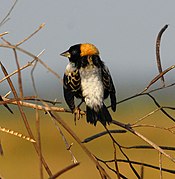 |
Dolichonyx Swainson, 1827 |
|
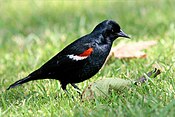 |
Agelaius Vieillot, 1816 |
|
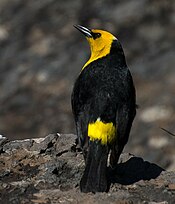 |
Xanthopsar Ridgway, 1901 |
|
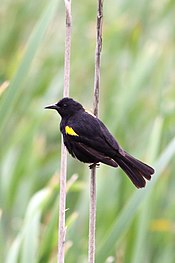 |
Agelasticus Cabanis, 1851 |
|
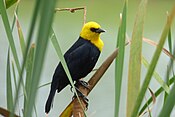 |
Chrysomus Swainson, 1837 |
|
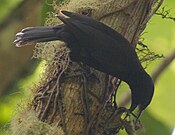 |
Nesopsar P.L. Sclater, 1859 |
|
 |
Sturnella Vieillot, 1816 |
|
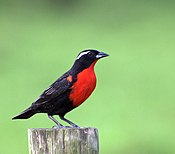 Brazil -8.jpg" decoding="async" srcset="//upload.wikimedia.org/wikipedia/commons/thumb/9/99/Sturnella_superciliaris_-Vale_do_Ribeira%2C_Registro%2C_Sao_Paulo%2C_Brazil_-8.jpg/263px-Sturnella_superciliaris_-Vale_do_Ribeira%2C_Registro%2C_Sao_Paulo%2C_Brazil_-8.jpg 1.5x, //upload.wikimedia.org/wikipedia/commons/thumb/9/99/Sturnella_superciliaris_-Vale_do_Ribeira%2C_Registro%2C_Sao_Paulo%2C_Brazil_-8.jpg/350px-Sturnella_superciliaris_-Vale_do_Ribeira%2C_Registro%2C_Sao_Paulo%2C_Brazil_-8.jpg 2x" data-file-width="1552" data-file-height="1362" height="154" width="175" /> Brazil -8.jpg" decoding="async" srcset="//upload.wikimedia.org/wikipedia/commons/thumb/9/99/Sturnella_superciliaris_-Vale_do_Ribeira%2C_Registro%2C_Sao_Paulo%2C_Brazil_-8.jpg/263px-Sturnella_superciliaris_-Vale_do_Ribeira%2C_Registro%2C_Sao_Paulo%2C_Brazil_-8.jpg 1.5x, //upload.wikimedia.org/wikipedia/commons/thumb/9/99/Sturnella_superciliaris_-Vale_do_Ribeira%2C_Registro%2C_Sao_Paulo%2C_Brazil_-8.jpg/350px-Sturnella_superciliaris_-Vale_do_Ribeira%2C_Registro%2C_Sao_Paulo%2C_Brazil_-8.jpg 2x" data-file-width="1552" data-file-height="1362" height="154" width="175" /> |
Leistes Vigors, 1825 |
|
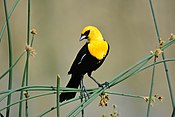 |
Xanthocephalus Bonaparte, 1850 |
|
 |
Dives Cassin, 1867 |
|
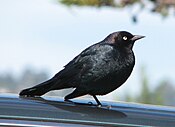 |
Euphagus Cassin, 1867 |
|
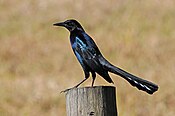 |
Quiscalus Vieillot, 1816 |
|
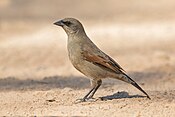 |
Agelaioides Cassin, 1866 |
|
 |
Molothrus Swainson, 1832 |
|
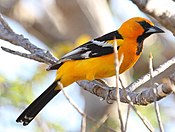 |
Icterus Brisson, 1760 |
|
 |
Amblycercus Cabanis, 1851 |
|
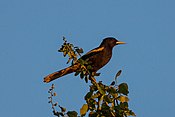 |
Cassiculus Swainson, 1827 |
|
 |
Cacicus Lacepede, 1799 |
|
 |
Psarocolius Wagler, 1827 |
|
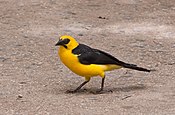 Venezuela.jpg" decoding="async" srcset="//upload.wikimedia.org/wikipedia/commons/thumb/4/4e/Gymnomystax_mexicanus_-_Tordo_maicero_-_Venezuela.jpg/263px-Gymnomystax_mexicanus_-_Tordo_maicero_-_Venezuela.jpg 1.5x, //upload.wikimedia.org/wikipedia/commons/thumb/4/4e/Gymnomystax_mexicanus_-_Tordo_maicero_-_Venezuela.jpg/350px-Gymnomystax_mexicanus_-_Tordo_maicero_-_Venezuela.jpg 2x" data-file-width="1947" data-file-height="1280" height="115" width="175" /> Venezuela.jpg" decoding="async" srcset="//upload.wikimedia.org/wikipedia/commons/thumb/4/4e/Gymnomystax_mexicanus_-_Tordo_maicero_-_Venezuela.jpg/263px-Gymnomystax_mexicanus_-_Tordo_maicero_-_Venezuela.jpg 1.5x, //upload.wikimedia.org/wikipedia/commons/thumb/4/4e/Gymnomystax_mexicanus_-_Tordo_maicero_-_Venezuela.jpg/350px-Gymnomystax_mexicanus_-_Tordo_maicero_-_Venezuela.jpg 2x" data-file-width="1947" data-file-height="1280" height="115" width="175" /> |
Gymnomystax L. Reichenbach, 1850 |
|
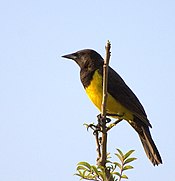 |
Pseudoleistes P.L. Sclater, 1862 |
|
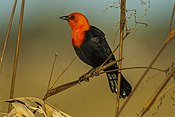 Brazil MG 9585 (23262522193).jpg" decoding="async" srcset="//upload.wikimedia.org/wikipedia/commons/thumb/8/8e/Scarlet-headed_Blackbird_-_Pantanal_-_Brazil_MG_9585_%2823262522193%29.jpg/263px-Scarlet-headed_Blackbird_-_Pantanal_-_Brazil_MG_9585_%2823262522193%29.jpg 1.5x, //upload.wikimedia.org/wikipedia/commons/thumb/8/8e/Scarlet-headed_Blackbird_-_Pantanal_-_Brazil_MG_9585_%2823262522193%29.jpg/350px-Scarlet-headed_Blackbird_-_Pantanal_-_Brazil_MG_9585_%2823262522193%29.jpg 2x" data-file-width="1140" data-file-height="760" height="117" width="175" /> Brazil MG 9585 (23262522193).jpg" decoding="async" srcset="//upload.wikimedia.org/wikipedia/commons/thumb/8/8e/Scarlet-headed_Blackbird_-_Pantanal_-_Brazil_MG_9585_%2823262522193%29.jpg/263px-Scarlet-headed_Blackbird_-_Pantanal_-_Brazil_MG_9585_%2823262522193%29.jpg 1.5x, //upload.wikimedia.org/wikipedia/commons/thumb/8/8e/Scarlet-headed_Blackbird_-_Pantanal_-_Brazil_MG_9585_%2823262522193%29.jpg/350px-Scarlet-headed_Blackbird_-_Pantanal_-_Brazil_MG_9585_%2823262522193%29.jpg 2x" data-file-width="1140" data-file-height="760" height="117" width="175" /> |
Amblyramphus Leach, 1814 |
|
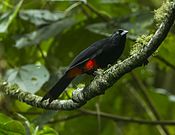 Colombia S4E5638 (23889365655).jpg" decoding="async" srcset="//upload.wikimedia.org/wikipedia/commons/thumb/c/cb/Red-bellied_Grackle_-_Medellin_-_Colombia_S4E5638_%2823889365655%29.jpg/263px-Red-bellied_Grackle_-_Medellin_-_Colombia_S4E5638_%2823889365655%29.jpg 1.5x, //upload.wikimedia.org/wikipedia/commons/thumb/c/cb/Red-bellied_Grackle_-_Medellin_-_Colombia_S4E5638_%2823889365655%29.jpg/350px-Red-bellied_Grackle_-_Medellin_-_Colombia_S4E5638_%2823889365655%29.jpg 2x" data-file-width="988" data-file-height="760" height="135" width="175" /> Colombia S4E5638 (23889365655).jpg" decoding="async" srcset="//upload.wikimedia.org/wikipedia/commons/thumb/c/cb/Red-bellied_Grackle_-_Medellin_-_Colombia_S4E5638_%2823889365655%29.jpg/263px-Red-bellied_Grackle_-_Medellin_-_Colombia_S4E5638_%2823889365655%29.jpg 1.5x, //upload.wikimedia.org/wikipedia/commons/thumb/c/cb/Red-bellied_Grackle_-_Medellin_-_Colombia_S4E5638_%2823889365655%29.jpg/350px-Red-bellied_Grackle_-_Medellin_-_Colombia_S4E5638_%2823889365655%29.jpg 2x" data-file-width="988" data-file-height="760" height="135" width="175" /> |
Hypopyrrhus Bonaparte, 1850 |
|
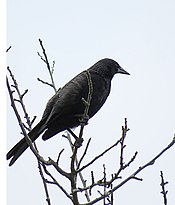 |
Curaeus (PL Sclater, 1862) |
|
| Anumara Powell et al., 2014 |
|
|
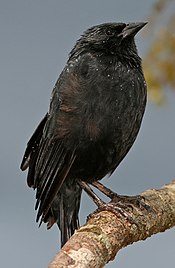 |
Gnorimopsar Richmond, 1908 |
|
| Oreopsar WL Sclater, 1939 |
|
|
| Lampropsar Cabanis, 1847 |
|
|
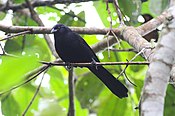 |
Macroagelaius Cassin, 1866 |
|
Prehistoric icterid genera that have been described from Pleistocene fossil remains are Pandanaris from Rancho La Brea and Pyelorhamphus from Shelter Cave.
References
Chesser, R. Terry; Burns, Kevin J.; Cicero, Carla; Dunn, Jon L.; Kratter, Andrew W.; Lovette, Irby J.; Rasmussen, Pamela C.; Remsen, J. V.; Rising, James D. (2017). "Fifty-eighth supplement to the American Ornithological Society's Check-list of North American Birds". The Auk. 134 (3): 751–773. doi:10.1642/auk-17-72.1.
Lowther P (1975) "Geographic and Ecological Variation in the Family Icteridae" Wilson Bulletin 87 (4): 481-495
Parkes, Kenneth C. (1991), Forshaw, Joseph (ed.), Encyclopaedia of Animals: Birds, London: Merehurst Press, pp. 214–215, ISBN 1-85391-186-0
Prum, Richard O.; Snow, David W. (2003), "Cotingas", in Christopher Perrins (ed.), Firefly Encyclopedia of Birds, Firefly Books, pp. 432–433, ISBN 1-55297-777-3
Dolbeer, R & S Ickes (1994) "Red-winged Blackbird feeding preferences and response to wild rice treated with Portland cement or plaster" Vertebrate Pest Conference Proceedings collection Proceedings of the Sixteenth Vertebrate Pest Conference (1994) (W.S. Halverson& A.C. Crabb, Eds.) Univ. of Calif.:Davis.
Manu Peru Manu - Aves, Enjoy Corporation S. A., 2007, archived from the original on 2006-02-25, retrieved 2007-09-28
Muyuna Amazon Lodge, Iquitos - Peru, retrieved 2007-09-28. Click the link to Fauna and scroll forward one page.
Moyobamba - Peru, 2007, archived from the original on 2008-01-06, retrieved 2007-09-28. The source given is Moyobamba, apuntes turísticos y geográficos by Pedro Vargas Roja.
Aves en Soritor - Distrito de soritor Moyobamba - Alto Mayo - San Martín - Peru, 2006, retrieved 2007-09-28
Jaramillo, Alvaro & Burke, Peter (1999): New World Blackbirds. Christopher Helm, London. ISBN 0-7136-4333-1
Price, J. Jordan & Lanyon, Scott M. (2002): A robust phylogeny of the oropendolas: Polyphyly revealed by mitochondrial sequence data. Auk 119(2): 335–348. DOI: 10.1642/0004-8038(2002)119[0335:ARPOTO]2.0.CO;2 PDF fulltext[dead link]
Bosque de Protección Alto Mayo - Perfil de Parque - Biodiversidad, ParksWatch, 2004, retrieved 2007-09-28. English version (not containing the word paucar).
Further reading
Powell, A.F.L.A.; Barker, F.K.; Lanyon, S.M.; Burns, K.J.; Klicka, J.; Lovette, I.J. (2014). "A comprehensive species-level molecular phylogeny of the New World blackbirds (Icteridae)". Molecular Phylogenetics and Evolution. 71: 94–112. doi:10.1016/j.ympev.2013.11.009. PMID 24291659.
Remsen, J.V. Jr.; Powell, A.F.L.A.; Schodde, R.; Barker, F.K.; Lanyon, S.M. (2016). "A revised classification of the Icteridae (Aves) based on DNA sequence data". Zootaxa. 4093 (2): 285–292. doi:10.11646/zootaxa.4093.2.9. PMID 27394496.
Retrieved from "http://en.wikipedia.org/"
All text is available under the terms of the GNU Free Documentation License

